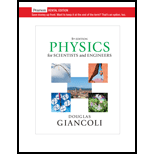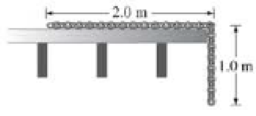
Concept explainers
(III) A 3.0-m-long steel chain is stretched out along the top level of a horizontal scaffold at a construction site, in such a way that 2.0 m of the chain remains on the top level and 1.0 m hangs vertically, Fig. 7–26. At this point, the force on the hanging segment is sufficient to pull the entire chain over the edge. Once the chain is moving, the kinetic friction is so small that it can be neglected. How much work is performed on the chain by the force of gravity as the chain falls from the point where 2.0 m remains on the scaffold to the point where the entire chain has left the scaffold? (Assume that the chain has a linear weight density of 18 N/m.)

FIGURE 7-26
Problem 49.
Let y represent the length of chain hanging over the table, and let λ represent the weight per unit length of the chain. Then the force of gravity (weight) of the hanging chain is FG = λy. As the next small length of chain dy comes over the table edge, gravity does an infinitesimal amount of work on the hanging chain given by the force tunes the distance. FGdy = λydy. To find the total amount of work that gravity does on the chain, integrate that work expression, with the limits of integration representing the amount of chain hanging over the table.
Want to see the full answer?
Check out a sample textbook solution
Chapter 7 Solutions
Pearson eText -- Physics for Scientists and Engineers with Modern Physics -- Instant Access (Pearson+)
Additional Science Textbook Solutions
Chemistry: Structure and Properties (2nd Edition)
Introductory Chemistry (6th Edition)
Campbell Essential Biology with Physiology (5th Edition)
Chemistry & Chemical Reactivity
Applications and Investigations in Earth Science (9th Edition)
Biology: Life on Earth (11th Edition)
- In order for Jane to return to base camp, she needs to swing across a river of width D that is filled with alligators. She must swing into a wind exerting constant horizontal force F, F = 110 N, L = 40.0 m, 0 = 50.0°, and her mass to be 50.0 kg. Wind →F Tarzan! Jane (a) with what minimum speed (in m/s) must Jane begin her swing to just make it to the other side? (If Jane can make it across with zero initial velocity, enter 0.) m/s on a vine having length L and initially making an angle with the vertical (see below figure). Take D = 48.0 m, (b) Shortly after Jane's arrival, Tarzan and Jane decide to swing back across the river (simultaneously). With what minimum speed (in m/s) must they begin their swing? Assume that Tarzan has a mass of 80.0 kg. m/sarrow_forwardR=2.00 12V 2.00 4.00 4.002 What is the current in one of the 4.0 Q resistors? An isolated point charge q is located at point X. Two other points Y and Z are such that YZ2 XY. Y X What is (electric field at Y)/(electric field at Z)?arrow_forwardTwo objects (m₁ = 4.75 kg and m₂ 2.80 kg) are connected by a light string passing over a light, frictionless pulley as in the figure below. The 4.75-kg object is released from rest at a point h = 4.00 m above the table mg m (a) Determine the speed of each object when the two pass each other. m/s (b) Determine the speed of each object at the moment the 4.75-kg object hits the table. m/s (c) How much higher does the 2.80-kg object travel after the 4.75-kg object hits the table? marrow_forward
- A cell of negligible internal resistance is connected to three identical resistors. The current in the cell is 3.0 A. The resistors are now arranged in series. What is the new current in the cell?arrow_forwardA negatively charged sphere is falling through a magnetic field. north pole of magnet direction of motion south pole of magnet What is the direction of the magnetic force acting on the sphere?arrow_forwardElectrons in a conductor are moving down the page. A proton outside the wire is moving to the right. What is the direction of the magnetic force acting on the proton?arrow_forward
- What is the resistance of an ideal voltmeter and the resistance of an ideal ammeter? Resistance of an ideal voltmeter Resistance of an ideal ammeter infinite A. zero B. zero zero C. infinite infinite D. infinite zeroarrow_forwardvariable resistor with a resistance range of 0 to 6.0 KQ is connected in series with two resistors of fixed value 6.0 KQ. The cell in the circuit has an emf of 18 V and a negligible internal resistance. 18 V X Y 6.0 ΚΩ 6.0 ΚΩ 0 - 6.0 ΚΩ What is the maximum range of potential difference that can be observed between X and Y?arrow_forwardA positive point charge of magnitude 1.0 μC and a point charge q are separated by a distance d. electron 1.0 με An electron is placed at a distance d from the +1.0 μC charge. The electric force on the electron is zero. What is q?arrow_forward
- Two point charges of +4q and -q are placed a fixed distance apart. Where is the electric field strength equal to zero? B. +49 D. A network of three resistors is connected to a cell of emf 12V and internal resistance R of 2.0 Q as shown.arrow_forwardThree point charges of equal magnitude are placed at the vertices of an equilateral triangle. The signs of the charges are shown. Point P is equidistant from the vertices of the triangle. What is the direction of the resultant electric field at P? B.arrow_forwardA magnetic force per unit length F acts on P due to Q. The distance between the wires is increased to 2d and the current in Q is decreased to 1/2. P Q P 12 2d What is the magnetic force per unit length that acts on P due to Q after the changes?arrow_forward
 College PhysicsPhysicsISBN:9781938168000Author:Paul Peter Urone, Roger HinrichsPublisher:OpenStax College
College PhysicsPhysicsISBN:9781938168000Author:Paul Peter Urone, Roger HinrichsPublisher:OpenStax College Principles of Physics: A Calculus-Based TextPhysicsISBN:9781133104261Author:Raymond A. Serway, John W. JewettPublisher:Cengage Learning
Principles of Physics: A Calculus-Based TextPhysicsISBN:9781133104261Author:Raymond A. Serway, John W. JewettPublisher:Cengage Learning College PhysicsPhysicsISBN:9781285737027Author:Raymond A. Serway, Chris VuillePublisher:Cengage Learning
College PhysicsPhysicsISBN:9781285737027Author:Raymond A. Serway, Chris VuillePublisher:Cengage Learning Physics for Scientists and Engineers: Foundations...PhysicsISBN:9781133939146Author:Katz, Debora M.Publisher:Cengage Learning
Physics for Scientists and Engineers: Foundations...PhysicsISBN:9781133939146Author:Katz, Debora M.Publisher:Cengage Learning University Physics Volume 1PhysicsISBN:9781938168277Author:William Moebs, Samuel J. Ling, Jeff SannyPublisher:OpenStax - Rice University
University Physics Volume 1PhysicsISBN:9781938168277Author:William Moebs, Samuel J. Ling, Jeff SannyPublisher:OpenStax - Rice University Classical Dynamics of Particles and SystemsPhysicsISBN:9780534408961Author:Stephen T. Thornton, Jerry B. MarionPublisher:Cengage Learning
Classical Dynamics of Particles and SystemsPhysicsISBN:9780534408961Author:Stephen T. Thornton, Jerry B. MarionPublisher:Cengage Learning





